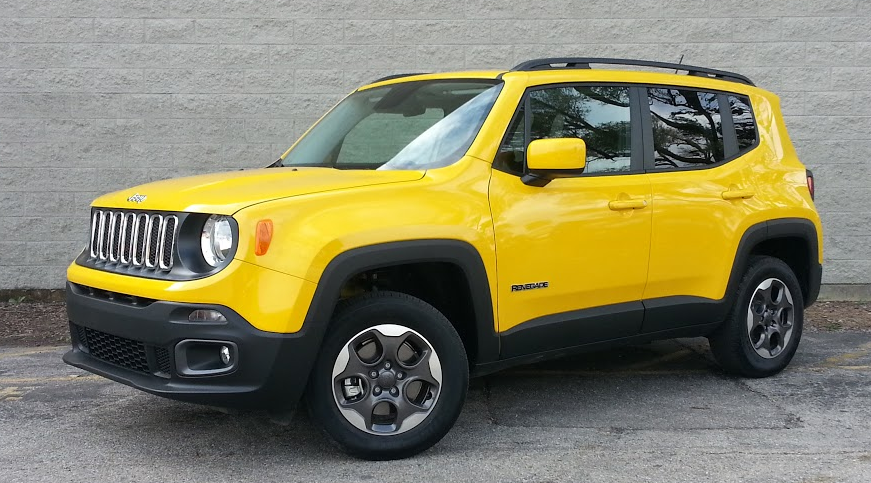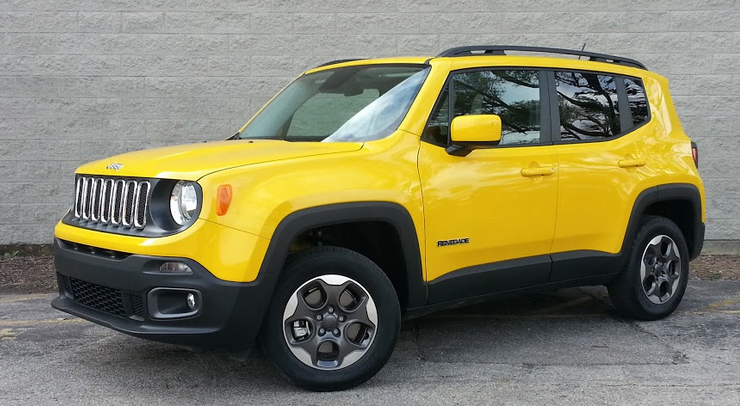
2015 Jeep Renegade Latitude 4×4
Class: Compact Crossover
Miles Driven: 339
Fuel Used: 13.9 gallons
Real-world fuel economy: 24.4 mpg
Driving mix: 70% city, 30% highway
EPA-estimated fuel economy: 24/31/27 (city, highway, combined)
Base price: $23,295 (not including $995 destination charge)
Options on test car: Tonneau cover ($75), My Sky power retractable/removable roof panels ($1395)
| CG Report Card | |
|---|---|
| Room and Comfort | B+ |
| Power and Performance | C+ |
| Fit and Finish | B- |
| Fuel Economy | B |
| Value | A- |
| Report-card grades are derived from a consensus of test-driver evaluations. All grades are versus other vehicles in the same class. Value grade is for specific trim level evaluated, and may not reflect Consumer Guide's impressions of the entire model lineup. | |
Price as tested: $25,760
Quick Hits
The great: Off-road ability, control layout
The Good: Manual-transmission shift action, cargo flexibility
The not so good: Front-seat comfort, visibility
Check out the Consumer Guide compact crossover Best Buys
John Biel
Some of the entries in the quickly emerging subcompact sport-utility field go a little light on off-pavement potential. Not the new Jeep Renegade.
The Renegade shares its core platform with the Fiat 500X that bows for 2016 but sports more ground clearance and the availability of two 4-wheel-drive systems—one of them genuinely ready for the boonies. The Jeep even looks the part, with the brand’s famous 7-slot grille, round headlights, and flat-surface body panels that make it look remotely like a scaled-down Wrangler Unlimited, that all-American favorite. However, this Jeep is built alongside its corporate cousin in Italy. (Maybe it should be pronounced reh-nay-GAH-day?)
Of the four available trim levels, three—Sport, Latitude, and Limited—come in a choice of front- or four-wheel drive. Only the fully off-road-ready Trailhawk is restricted to a 4X4 drivetrain. Consumer Guide® tested the Latitude with Active Drive 4-wheel drive.
Active Drive includes “Auto,” “Snow,” “Sand,” and “Mud” settings, summoned via a rotating dial near the floor—a device that Jeep calls Selec-Terrain. For fuel savings, Active Drive automatically engages the rear axle only when wet or slick surfaces increase the need for traction, monitoring wheel slip and transferring torque where needed. (A tap on the dial activates a 4-wheel lock that keeps both axles in play if desired.) Note that the Trailhawk has an Active Drive Low version of the system with an added 4WD-low range, hill-descent control, and a “Rock” surface setting. This tester’s commuting on dry neighborhood streets and urban expressways didn’t put any strain on the Latitude’s Active Drive, but an earlier chance to briefly drive a Trailhawk in the Mud setting and 4-wheel low over an off-road course showed it to have decent climbing ability and effective hill-descent engagement.
Like the base Sport, the Latitude comes standard with a 1.4-liter turbocharged 4-cylinder engine of 160 hp and a 6-speed manual transmission. (A naturally aspirated 2.4-liter 180-hp engine with 9-speed automatic trans is available.) CG’s test vehicle had the standard powerteam. The turbo engine is peppy enough once it has a chance to build some revs, which judicious working of the manual gearbox permits. (The shifter is pleasingly direct to operate, by the way, and with a little more gradual clutch take-up, the manual would be just about ideal.) This driver’s turn resulted in a 167.4-mile trip. With 70 percent of that in city-type driving, he averaged 25.11 mpg. That’s pretty well in line with EPA projections of 24 mpg in the city, 31 on the highway, and 27 mpg combined.
A 4WD Latitude starts at $23,295. (Front-drive models are $2000 cheaper.) Standard features that make it stand out from the entry-level Sport include 16-inch aluminum wheels, deep-tint sunscreen glass, a leather-wrapped steering wheel, rearview camera, a 5-inch-touchscreen version of the corporate Uconnect infotainment system with hands-free calling, and fog lamps. The Latitude that CG sampled came to $25,760 with delivery and a pair of options—a cargo-area cover and the “My Sky” retractable and removable roof panels.
In a lot of other vehicles, the Latitude’s abundance of hard-plastic interior surfaces—relieved only by cloth on all door arm rests and the leather on the steering wheel—would be a sign of parsimonious cost cutting. Here, though, it seems in character for an almost-all-in off-roader, imparting a no-nonsense “wipe-it-down-and-go” air. Controls are easy to reach and use. Three-dial climate settings couldn’t be easier to deal with. While the Selec-Terrain dial sits a bit low, drivers probably won’t be adjusting this often.
As for comfort, the tight body structure contributes to a stable ride for the class, and the Renegade handles easily. The cloth-trimmed seats are firm, so support is there, but seat construction is such that you feel individual panels and segments in your back and bottom, so general comfort suffers somewhat. Front passengers will find pretty good stretch-out room but rear leg room is less abundant, especially behind long-limbed front riders. Head room is generous everywhere. Three adults may pinch in across the rear seat for a short hop, but two-across is more realistic. Entry/exit is easy; over-the-shoulder visibility suffers a little from thick roof pillars.
For personal items, the front doors each have a small pocket with a bottle holder; rear doors have just a bottle holder. There’s a pretty big glove box but a small console cubby. (At least the latter is deep and houses a USB port). Front passengers also can take advantage of a small open bin near the USB/auxiliary-input/power-point block at the front of the console, and two open cup holders. Rear passengers just have pouches on back of both front seats—though dual cup holders are included when 40/20/40 seats are ordered.
There’s much flexibility in rear cargo storage. The floor can be configured for flat bumper-height loading, or the panels can be removed to provide a little more load depth. (Indeed, with the panels in place, there’s a hidden space under the floor.) Either way, the Renegade might carry a fair amount of gear for two people. Standard Latitude seats fold 60/40; when the cargo-floor panels are in place, there’s an unbroken transition to this added cargo space.
For the buyer in this segment whose needs—or personal tastes—call for more than a miniwagon with a little extra ground clearance, the Renegade provides that something extra. Fortunately, in the Latitude model, that “extra” does not necessarily mean dollars.
